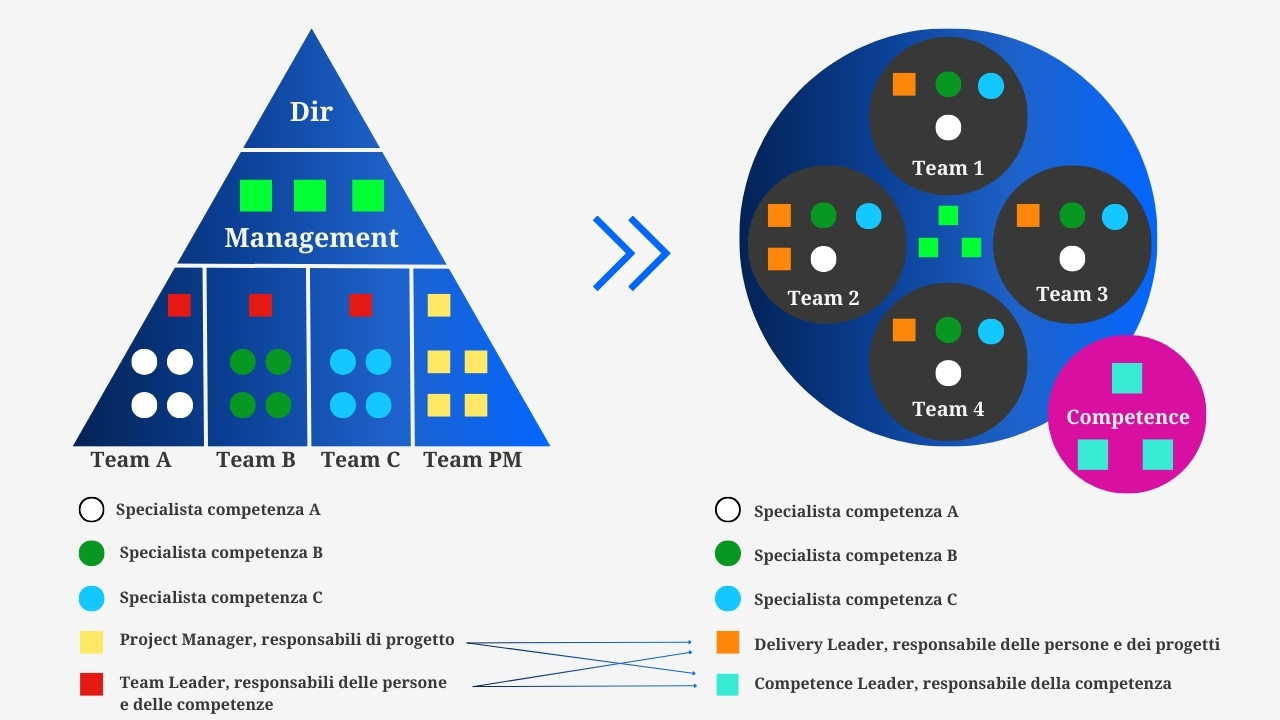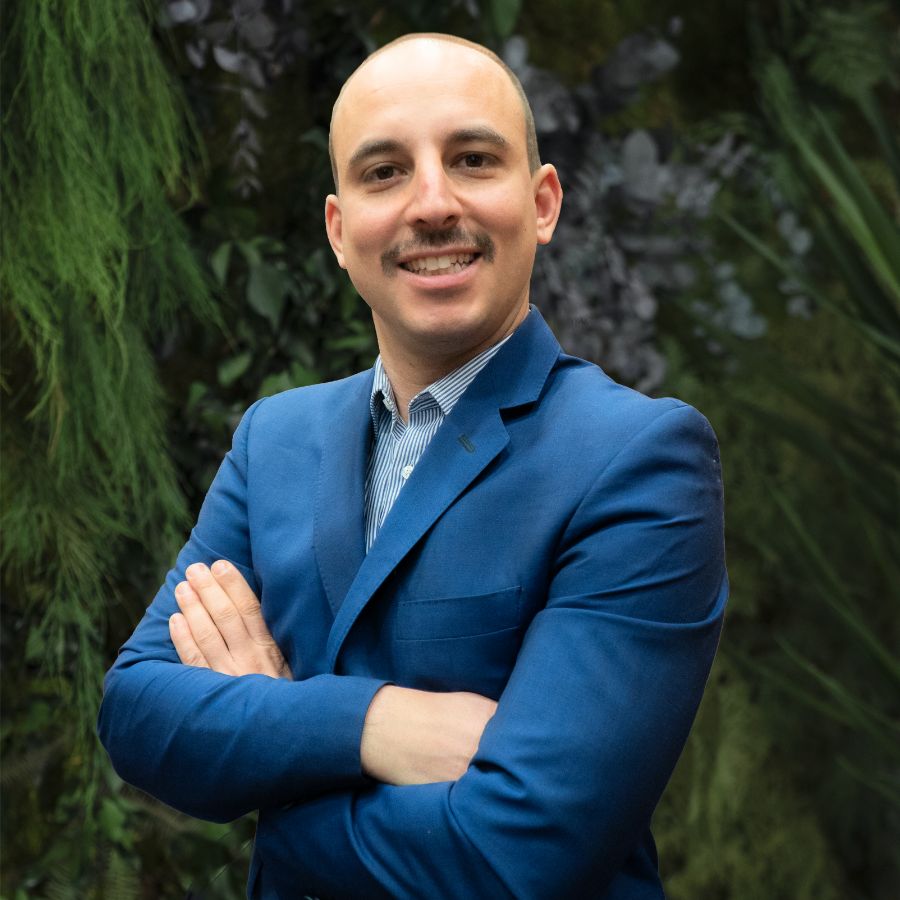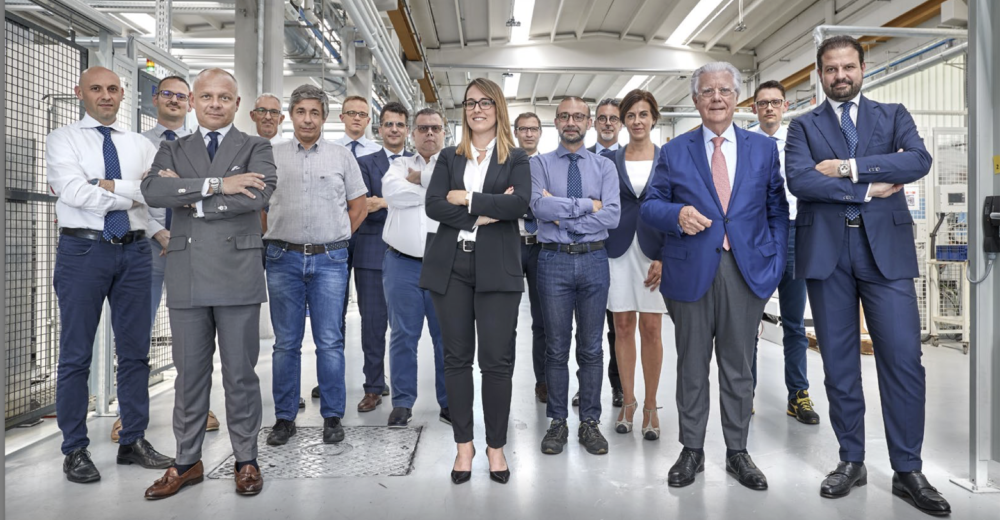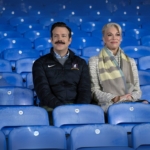An agile organization, done seriously

Indice
To become agile, it is not enough to have agile roles and routines or worse, to mimic SCRUM jargon: you must have the courage to get your hands on the organization, dismantling the hierarchies and structures inherited from the past: introducing teams that work on the same desk, with different rewards but linked to the same objectives. We need teams led by leaders who care about both the results and the well-being of the people, which cannot be delegated to HR or others.
“In the army, I saw firsthand how the power of small teams can achieve extraordinary results. A bond is created when a group works together with a shared purpose and clear goals. This is the essence of SCRUM: building a collaborative environment where team members are empowered.”
This is a quote by Jeff Sutherland, the founding father of the SCRUM framework, described in his best seller “Doing twice as much in half the time”.
When I first read this text years ago to “drink at the source” of those who had first grounded the agile approach to project management, I never expected that many of its references and inspirations would come from the military world, which I did not connect to something “creative” such as product or software development. But once I got over my prejudice, finished reading and applied the framework in different projects and organizations, I experienced firsthand and understood more deeply what the 2 psychological elements underlying the functioning of an agile team are:
- commitment to a single shared result
- Meaningful relationships with other team members.
Just eliminate one of the two and the foundation on which the team rests will crack.
The Méthode case
Méthode is a consulting firm in the field of Business and Advanced Analytics, based in Conegliano, which deals with Business (& Artificial) Intelligence solutions, from the sale of software licenses of the main international software vendors to the implementation of data warehouses, data lake, operational and directional dashboards, predictive algorithms and artificial intelligence.
Despite the company’s commercial success and growth in the sector, in the years following the pandemic, Méthode was facing a significant problem: high staff turnover, certainly linked to great resignation and higher mobility typical of the IT sector, but most likely also to a company climate under the expectations of the same partners who have measured it every year with the Great Place to Work (GPTW) thermometer and with some external evaluations. The partners in April 2023 asked us for help to move from “symptoms” to therapy.
The initial situation
Méthode employs about seventy consultants who until December 2023 were organized in specialized teams by consulting area: the team for database management, the one for programming, the one for front end, etc.
Their team leaders were responsible for evaluating the performance, professional growth, well-being and technical mentoring of the consultants. However, in practice they were able to concentrate mainly on the latter aspect only, because for most of their time the consultants were “in the hands” of the Project Managers.
Coordinated by a leader, 10-12 project managers (PM) were (and are) in charge of guiding projects for clients.
The PMs were responsible for coordinating functionally these consultants, guiding them on the various clients and projects to which they had been assigned according to their specific expertise.
This organizational model meant that consultants were moved from one project to another, often working with different teams, for different clients and for short periods of time. The PMs, being closer to the day-to-day work of consultants, had more information to assess their performance and impact on the client – and above all influence their well-being.
This organization created a discrepancy in the facts between the formal and actual responsibilities of team leaders and PMs:
- the first with responsibility for people but with less leverage in everyday life to affect their performance and well-being,
- the latter in a reverse situation: without the responsibility of people, but with more levers.
Consultants were constantly in demand from various PMs, often to work on many projects simultaneously and with frequent team changes and clients. This created stress on the consultants as they had to continually acquire new information and handle delivery, a non-value-added activity.
In addition, some consultants did not feel sufficiently involved by the PMs on turnover and quality targets. Objectives that, moreover, weighed more on the rewards of the PM than on those of the consultants creating a gap in responsibility and orientation to the result (i.e. who exposes himself/ herself in first person with the client).
“The organization we had before contacting Lenovys was the result of a path born some years ago, when there were fewer employees, and the relationships generated by this matrix were sustainable. As the structure grew, some critical points emerged, through the constant work of listening that we have implemented over time, also thanks to external consultants”
Diego Sossai – Sales Director, Lean Innovation and Méthode partner
Stefano Magoga – Director Solutions and Partners Methode
The new organization and adaptation of the SCRUM model
We tried to apply the SCRUM framework to projects but especially to teams: we had to put under a single structure the responsibility of quality-cost-project time (the classic cornerstones of project management), and responsibility for the development and well-being of people.
And so, we introduced the figure of the Delivery Leader to highlight the change of role and the extension of their perimeter: not only the delivery of projects, but also the people entrusted to them.
These Delivery Leaders, selected from those who in the previous organization held the role of either Team Leader or PM, were put at the head of teams of 6-8 members that, according to the principles of SCRUM, they had to have all the skills in order to deliver value to the customer: there had to be someone who was responsible for the back end and someone from the front end for all the technologies (Qlik, Microsoft, SAP, etc.) used in the customer package assigned to the team.
This last element, assigning a client (or at least most of its projects) to a single team was probably what created the most “scrum package” dynamic at the base of the SCRUM method: all committed to the same clients and projects because what we deliver is the result of our group work, which is much more than the sum of individual contributions. And above all “we each cover the other’s back”, to use another military metaphor that Sutherland often quotes.
Delivery Leaders were trained on the principles of “servant leadership” underlying lean and agile culture and then guided in adapting roles and ceremonies typical of SCRUM to their context: sprint planning, sprint review, scrum master, etc.

The image offers a simplified version of how it was and how it is now with the Méthode consultants, and does not represent other functions (Sales, Administration, HR…) that still interact with agile teams.
The A, B and C teams were organized by competence; today they have become multidisciplinary (Team 1, 2, 3, 4) and their members can deliver value to the assigned customer package without having to refer to other structures and referring to one leadership.
For the more complex technical aspects, a structure has been built which we have called “Competence”, with the most experienced people on the single technology or methodology.
As leaders moved from one organization to another, they took a different path depending on their skills in managing projects, people and competencies, knowing that whatever the role was they would have to adopt a new style of leadership.
“People were involved from the very beginning of this reorganization, precisely because a change was planned which involved many aspects of each person’s daily work. It was essential to “have people on board”, propose a cultural change, and start the reorganization strong consensus obtained”
Davide Marangoni, Human Resources Director and Méthode partner
The changes to be made to make everything consistent with the new organization were many: from business routines to align sales with delivery, to the new arrangement of teams in the work tables.
One of the most important aspects was to build compensation policies that would allow consultants to grow based on taking responsibility within projects, which was previously in the hands of PMs almost exclusively.
We have also aligned performance indicators, targets and associated rewards – of the Delivery Leaders and consultants – to make more equitable the production and distribution of value towards Méthode and its customers: the whole team today pursues the same performance goals and – although to a different extent depending on the level of responsibility – the whole team is rewarded according to whether or not they have achieved those goals, whose indicators are clearly visible in the control dashboards shared with all members.
From the psychological point of view, the most important aspect concerns internal relations.
The continuous change of teams and the pressure from PMs probably undermined the sense of belonging and cohesion among consultants. This can lead to a less collaborative and more competitive work environment, negatively affect the business climate and contribute to high staff turnover.
The first results
Six months after the new organization was implemented, both partners and employees felt a clear change in climate. The GPTW survey of June 2024 on the analysis of business climate has shown that the path taken is positive. This year’s results represent the best result for Méthode since it started this initiative seven years ago, an improvement of 6 percentage points compared to 2023.
It is still too early to make definitive assessments, as the time spent is still insufficient to assess actual impacts on turnover and overall productivity and business improvements.
The strengths of the Great Place to Work results are in the areas where they were intended to be applied, namely:
- management quality and integrity
- respect and appreciation of people
- people’s collaborative contribution
Two of the many statements that GPTW monitors (“Managers have a clear vision of business goals and how to achieve them” and “Managers assign assignments and coordinate people effectively”) showed a significant improvement over last year, with an increase of more than 22 percent points.
This confirms that the interventions were effective and perceived, highlighting a renewed culture of trust among the people of Méthode.
“After some time from the go live of the new organization we feel a positive climate: routines that seemed artificial are now natural and lived as a pivotal moment of the day.
We have modified the offices to make the space welcoming compared to these new habits, and what we can see is a different way of living the office; you feel less tension and more energy”
Marco Antoniazzi, Paolo Zago – Delivery Directors and Méthode partners
Routines are not enough!
Many organizations boast of having introduced Agile into their project management, abandoning the so-called cascade approach and building cross-functional teams that drive projects forward. Often these teams have regular meetings, sometimes even daily to take stock of the situation in front of the famous scrum board.
But, from our perspective as consultants, in most cases the people of that team at the end of the daily scrum return to their silos, their functions, “under their head” and other contingencies. And the project they were working on is secondary to the urgency and operativity.
It is not possible to introduce the Agile method of project management in all organizations and at the same time revolutionize teams and hierarchies, precisely because Agile gives this last word a lower weight than more vertical organizations.
And yet, even when you cannot do such radical reorganizations, it is essential to introduce not only agile routines but also physical workplaces where the team can work together on the project for at least one day a week, each with his activities but with the possibility of immediately and verbally comparing with a colleague to understand more easily “what is the value for the customer” and then “how to deliver it.
“If you can’t put a team together in the same physical space, you’re giving up much of what makes them work,” to quote Sutherland.
Co-location brings people together in a way that nothing else can: it promotes better communication, faster problem solving and a deeper sense of camaraderie, not to be understood as political or military, but in its most original meaning of friendship and solidarity.
Tips and Red Flags for the Agile framework
Articolo a cura di:

Alessandro Valdina
Principal
In his university studies there are Communication, Finance and Applied Behavior Analysis. Head of Lenovys' "People & Organization" area, as a management consultant helps organizations achieve safety, quality, production, service and sales goals through measurable improvement in individual and group behaviors. His areas of expertise cover Change Management, Strategy Deployment, Lean Office, Performance Management, Leadership Development and Training Technologies.
Read more
Prossimi eventi










